Definition: The law of diminishing marginal utility explains that with the consumption of each subsequent unit of a commodity, the satisfaction anticipated or derived from it goes on declining. The point at which the consumer no more feels the need for consuming a particular product is referred to as the ‘Point of Satiety’. This is the point where the marginal utility curve cuts the axis when plotted on a graph.
In simple words, the law of diminishing marginal utility explains that everything has its utility which diminishes with the use of each unit this utility diminishes.
Content: Law of Diminishing Marginal Utility
Assumptions for Law of Diminishing Marginal Utility
To understand the law of diminishing marginal utility more realistically, the economists have assumed a specific set of conditions related to the consumer and the commodity.
These assumptions are explained in detail below:
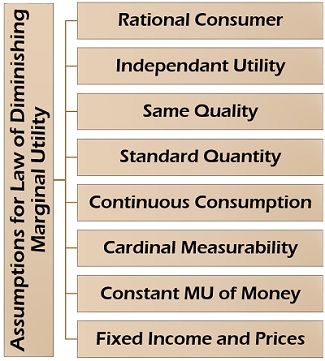
- Rational Consumer: A consumer looks for maximum satisfaction and is aware of the amount of satisfaction he derives from a commodity.
- Independent Utility: Each commodity has its utility, and it is assumed that only one product is consumed at a time.
- Same Quality: The commodities consumed must be of uniform quality throughout the process.
- Standard Quantity: The commodities must not differ in size, proportion or quantity.
- Continuous Consumption: The commodity must be consumed one after the other at the same time without any interval.
- Cardinal Measurability: It is assumed that the utility of a commodity can be measured quantitatively, i.e. in numbers like 10, 11, 12, 13, and so on.
- Constant MU of Money: In the concept of diminishing marginal utility, it is assumed that the marginal utility of the money spent on the commodity is consistent throughout the process.
- Fixed Income and Prices: It is believed that the income level of the consumer remains constant, and even the price of the commodity does not change.
Example
Let us now understand the law of diminishing marginal utility with an example;
Ms X found six packets of chocolate lying in her refrigerator. She noticed that the expiry date of these chocolates is nearby. To avoid the wastage and please her sweet tooth, she decided to eat all of these chocolates.
Law of Diminishing Marginal Utility Schedule
The following table will clearly illustrate the law of diminishing marginal utility:
| Point | Units Consumed (Packets of Chocolates) | Utility Derived (Utils) |
|---|---|---|
| A | 1st Packet | 100 |
| B | 2nd Packet | 75 |
| C | 3rd Packet | 50 |
| D | 4th Packet | 25 |
| E (Point of Satiety) | 5th Packet | 0 |
| F | 6th Packet | -25 |
She ate the first one being delighted and was extremely satisfied with consuming it. She then grabbed the second one, but her satisfaction level from this packet was slightly low.
Then, with each consecutive packet of chocolate, the satisfaction level of X goes on decreasing and reaches a point of satiety (at point E). At this point, she was not deriving any satisfaction from her consumption.
At point F, we can see that the marginal utility becomes negative, indicating that X is getting a negative satisfaction from her consumption.
Law of Diminishing Marginal Utility Graph
The concept of diminishing marginal utility can be well understood below where we have plotted the marginal utility curve or line for the above example on a graph:
Exceptions of Diminishing Marginal Utility
As we know that the law of diminishing marginal utility is not universally applicable in all situations.
Following are some of the exceptional cases where this law is inapplicable:
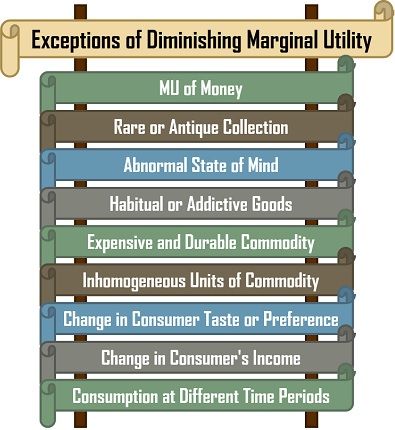
MU of Money: This law is not applicable when the commodity consumed is money. Since the marginal utility of money goes on increasing as the person gets or spends more and more of it.
Rare or Antique Collection: The law of diminishing marginal utility is inapplicable in case of rare collectables such as paintings, antiques, old coins, stamps, etc. Since customers of such products always crave for more of it.
Abnormal State of Mind: In the case of the unstable mental condition of a consumer, he/she may not be aware of what one is consuming. Thus, being negligent of the utility he/she is deriving out of it.
Habitual or Addictive Goods: When the consumer is obsessive about consuming a particular commodity such as alcohol or drugs, he will always want more of it.
Expensive and Durable Commodity: This law does not apply to the commodities which involve colossal sum and tend to last for years. The reason is that the consumer will not spend repetitively on such things; some of these are diamonds, property and vehicle.
Inhomogeneous Units of Commodity: Sometimes, the units of a commodity differ in size, proportion, shape, features, quality, etc. Therefore, the marginal utility derived from consuming the second unit may be higher than that of the first one; if the second unit is better than the first one in any sense.
Change in Consumer Taste or Preference: If the consumer’s choice for commodity changes, the marginal utility will not be the same as it used to be previously, for the consumer.
Change in Consumer’s Income: With the increase in consumer’s income, he may consume more and more of the preferred commodity leading to an increasing marginal utility.
Consumption at Different Periods: Another condition is a timed lap between the use of the subsequent units of a commodity. In this case, the marginal utility derived from such units can no longer be related to each other.
Importance of Diminishing Marginal Utility
This law is of considerable significance to the economists, government, business units and researchers. The primary need for diminishing marginal utility law are as follows:
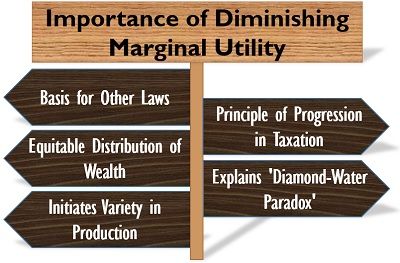 The concept of progressive taxation is based on this law. As it is assumed that, with the rise in income of the consumer, the MU of money falls for him/her.
The concept of progressive taxation is based on this law. As it is assumed that, with the rise in income of the consumer, the MU of money falls for him/her.
It also provides as a base for other laws in economics like the consumer’s equilibrium, the law of demand and law of equi-marginal utility.
This law is considered by socialist too, as they believe that the marginal utility of money is less for the rich. Therefore, to allocate the wealth equally, the surplus available with rich must be distributed among the poor.
‘Paradox of Value’, also known as ‘Diamond-water paradox‘ which helps to determine the price of a product, is also backed up by the law of diminishing marginal utility.
Diamond being scarce has a high MU leading to its high rate. Whereas, water being readily available, has a low MU (though, it has high total utility) which makes it remarkably cheaper as compared to the diamonds.
Moreover, using the same product again and again decreases the satisfaction of consumers, i.e. the MU of the product declines. They always look for a new product which is more appealing than the old one. Thus, alarming the producers to manufacture a different variety of products.
Limitations of Law of Diminishing Marginal Utility
Like other economic concepts, the law of diminishing marginal utility is also criticised by some economists on the grounds of the following drawbacks it pertains:
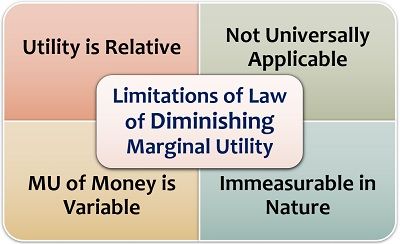
- Utility is Relative: The utility of a commodity can never be independent since it varies with the change in price or quantity of the complementary goods.
- Not Universally Applicable: This law does not apply to all the commodities since some commodities have an increasing marginal utility like addictive items, money, games, sports, collectables, etc.
- MU of Money is Variable: In the real world, the satisfaction level derived from money keeps on increasing which is contradictory to the law of diminishing marginal utility.
- Immeasurable in Nature: The utility, i.e. satisfaction, contentment, joy, happiness, pleasure, etc. are generally considered to be as a person’s feeling, experience or emotion which cannot be practically measured in units.
Law of diminishing marginal utility is a microeconomics approach accepted by some economists and rejected by the others who believe that utility of products cannot be measured in units.
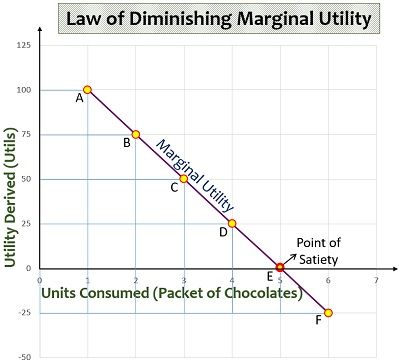
Leave a Reply